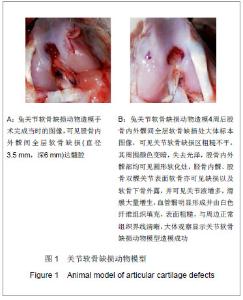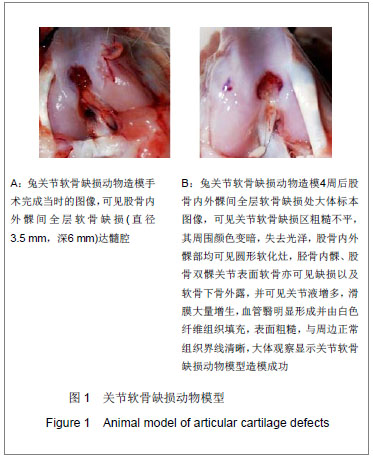Chinese Journal of Tissue Engineering Research ›› 2013, Vol. 17 ›› Issue (28): 5157-5163.doi: 10.3969/j.issn.2095-4344.2013.28.010
Previous Articles Next Articles
Cyclic tensile stress affects the expression of matrix metalloproteinases in chondrocytes
Liu Xing-mo, Sun Qing, Xiang Yu-cheng, Mei Xin-jun, Huang Sheng, Pan Tao
- Department of Orthopedics, the Sixth Affiliated Hospital of Sun Yat-sen University, Guangzhou 510655, Guangdong Province, China
-
Online:2013-07-09Published:2013-07-09 -
About author:Liu Xing-mo, M.D., Associate chief physician, Associate professor, Department of Orthopedics, the Sixth Affiliated Hospital of Sun Yat-sen University, Guangzhou 510655, Guangdong Province, China liuxingmo@163.com -
Supported by:Science and Technology Planning Project of Guangdong Provincial Science and Technology Department, No. 2010B031100025*;
Guangdong Province Medical Research Foundation, No. A2010204*
CLC Number:
Cite this article
Liu Xing-mo, Sun Qing, Xiang Yu-cheng, Mei Xin-jun, Huang Sheng, Pan Tao. Cyclic tensile stress affects the expression of matrix metalloproteinases in chondrocytes[J]. Chinese Journal of Tissue Engineering Research, 2013, 17(28): 5157-5163.
share this article

2.1 关节软骨缺损动物造模后大体观察 造模术后双膝活动少,至术后1周时活动增加,可正常行走,手术切口均无感染,愈合良好。 术侧兔膝关节均出现肿胀及变形,4周后关节软骨缺损区粗糙不平,周围颜色明显变暗,失去原有光泽,股骨内外髁部均可见圆形软化灶,胫骨内髁及股骨双髁关节表面软骨亦可见缺损以及软骨下骨外露,可见关节液增多,滑膜大量增生,血管翳明显形成并由白色纤维组织填充,表面粗糙,与周边正常组织界线清晰。 非手术侧兔膝关节未见明显积液,滑膜无增生,关节软骨面色泽明亮且光滑。 大体观显示关节软骨缺损动物模型造模成功,见图1。 2.2 加载周期性张应力后RT-PCR测定各组基质金属蛋白酶的表达 加载周期性张应力24 h后,正常组及对照组间的基质金属蛋白酶2,3,9,13的表达差异有显著性意义(P < 0.05);加载周期性张应力1周、2周及4周后高应力组和低压力组间差异有显著性意义(P < 0.05);同时发现,低应力组中基质金属蛋白酶2,3,9,13的表达持续下降,加载周期性张应力24 h与4周之间的差异有显著性意义(P < 0.05),见图2。"

| [1]刘兴漠,项禹诚,潘滔,等.胶原/羟基磷灰石一体化支架修复关节软骨缺损的机制研究[J].中国康复理论与实践,2012,18(1): 37-40.[2]刘兴漠,项禹诚,孙青,等.周期性张应力对骨性关节炎软骨细胞p38MAPK表达及其磷酸化的影响[J].中国病理生理杂志,2012, 28(2):362-365,370.[3]Beris AE, Lykissas MG, Papageorgiou CD,et al. Advances in articular cartilage repair.Injury. 2005;36 Suppl 4:S14-23.[4]晏丹,周广东,曹谊林.关节软骨生化结构及其与力学性能关系研究进展[J].上海交通大学学报:医学版,2009,29 (3):341-345.[5]彭雪林,张利,李玉宝,等.关节软骨缺损修复的研究与进展[J].中国组织工程研究与临床康复,2007,11 (2):336-339.[6]McNickle AG, Provencher MT, Cole BJ. Overview of existing cartilage repair technology.Sports Med Arthrosc. 2008; 16(4): 196-201.[7]Martinek V, Ueblacker P, Imhoff AB.Current concepts of gene therapy and cartilage repair.J Bone Joint Surg Br. 2003;85(6): 782-788.[8]马树强,姬海鹏,王坤正,等.骨-骨膜复合组织与软骨下钻孔治疗关节软骨缺损的实验研究[J].陕西医学杂志,2004,33(5) : 390-392.[9]刘尚礼,李卫平,宋卫东.软骨细胞移植治疗关节软骨缺损[J].广州医药,2000,31(2): 1-4.[10]Drury JL, Mooney DJ. Hydrogels for tissue engineering: scaffold design variables and applications. Biomaterials. 2003;24(24):4337-4351.[11]刘兴漠,项禹诚,麦海民,等.关节软骨-骨一体化修复体修复全层关节软骨缺损的实验研究[J].中华骨科杂志,2011,31(4): 365-371.[12]Cuenda A, Rousseau S. p38 MAP-kinases pathway regulation, function and role in human diseases. Biochim Biophys Acta. 2007;1773(8):1358-1375.[13]Han J, Lee JD, Bibbs L,et al. A MAP kinase targeted by endotoxin and hyperosmolarity in mammalian cells.Science. 1994;265(5173):808-811.[14]Lee JC, Laydon JT, McDonnell PC,et al. A protein kinase involved in the regulation of inflammatory cytokine biosynthesis. Nature. 1994;372(6508):739-746.[15]Rouse J, Cohen P, Trigon S,et al. A novel kinase cascade triggered by stress and heat shock that stimulates MAPKAP kinase-2 and phosphorylation of the small heat shock proteins.Cell. 1994;78(6):1027-1037.[16]Freshney NW, Rawlinson L, Guesdon F,et al. Interleukin-1 activates a novel protein kinase cascade that results in the phosphorylation of Hsp27.Cell. 1994;78(6):1039-1049.[17]Wada Y, Shimada K, Sugimoto K,et al. Novel p38 mitogen-activated protein kinase inhibitor R-130823 protects cartilage by down-regulating matrix metalloproteinase-1,-13 and prostaglandin E2 production in human chondrocytes.Int Immunopharmacol. 2006;6(2):144-155.[18]Link DP, Strandberg JD, Virmani R,et al. Histopathologic appearance of arterial occlusions with hydrogel and polyvinyl alcohol embolic material in domestic swine. J Vasc Interv Radiol. 1996;7(6):897-905.[19]Erskine RM, Jones DA, Williams AG,et al. Resistance training increases in vivo quadriceps femoris muscle specific tension in young men.Acta Physiol (Oxf). 2010;199(1):83-89.[20]D'Antona G, Lanfranconi F, Pellegrino MA,et al. Skeletal muscle hypertrophy and structure and function of skeletal muscle fibres in male body builders. J Physiol. 2006;570(Pt 3):611-627.[21]Hinz B, Brune K. Pain and osteoarthritis: new drugs and mechanisms. Curr Opin Rheumatol. 2004;16(5): 628-633.[22]Poole CA.Articular cartilage chondrons: form, function and failure. J Anat. 1997;191 ( Pt 1):1-13.[23]Thiede RM, Lu Y, Markel MD. A review of the treatment methods for cartilage defects.Vet Comp Orthop Traumatol. 2012;25(4):263-272.[24]Hurtig M, Pearce S, Warren S,et al. Arthroscopic mosaic arthroplasty in the equine third carpal bone.Vet Surg. 2001; 30(3):228-239.[25]Solheim E, Hegna J, Oyen J,et al. Osteochondral autografting (mosaicplasty) in articular cartilage defects in the knee: results at 5 to 9 years. Knee. 2010;17(1):84-87.[26]Bugbee WD. Fresh osteochondral allografts. J Knee Surg. 2002;15(3):191-195.[27]Stevenson S, Dannucci GA, Sharkey NA,et al. The fate of articular cartilage after transplantation of fresh and cryopreserved tissue-antigen-matched and mismatched osteochondral allografts in dogs. J Bone Joint Surg Am. 1989;71(9):1297-1307.[28]Danisovic L, Varga I, Zamborsky R,et al.The tissue engineering of articular cartilage: cells, scaffolds and stimulating factors.Exp Biol Med (Maywood). 2012;237 (1):10-17. [29]Nah SS, Choi IY, Yoo B,et al. Advanced glycation end products increases matrix metalloproteinase-1, -3, and -13, and TNF-alpha in human osteoarthritic chondrocytes. FEBS Lett. 2007;581(9):1928-1932.[30]Lin PM, Chen CT, Torzilli PA. Increased stromelysin-1 (MMP-3), proteoglycan degradation (3B3- and 7D4) and collagen damage in cyclically load-injured articular cartilage. Osteoarthritis Cartilage. 2004;12(6):485-496.[31]Wada Y, Shimada K, Sugimoto K,et al. Novel p38 mitogen-activated protein kinase inhibitor R-130823 protects cartilage by down-regulating matrix metalloproteinase-1,-13 and prostaglandin E2 production in human chondrocytes.Int Immunopharmacol. 2006;6(2):144-155.[32]Holm L, van Hall G, Rose AJ,et al. Contraction intensity and feeding affect collagen and myofibrillar protein synthesis rates differently in human skeletal muscle. Am J Physiol Endocrinol Metab. 2010;298(2):E257-269.[33]Mackey AL, Donnelly AE, et al. Turpeenniemi-Hujanen T,Skeletal muscle collagen content in humans after high-force eccentric contractions. J Appl Physiol. 2004;97(1):197-203.[34]Moore DR, Phillips SM, Babraj JA,et al. Myofibrillar and collagen protein synthesis in human skeletal muscle in young men after maximal shortening and lengthening contractions.Am J Physiol Endocrinol Metab. 2005;288(6): E1153-1159.[35]Hollander MS, Baker BA, Ensey J,et al. Effects of age and glutathione levels on oxidative stress in rats after chronic exposure to stretch-shortening contractions. Eur J Appl Physiol. 2010;108(3):589-597.[36]Baker BA, Hollander MS, Kashon ML,et al. Effects of glutathione depletion and age on skeletal muscle performance and morphology following chronic stretch-shortening contraction exposure. Eur J Appl Physiol. 2010;108(3):619-630.[37]Warner SE, Sanford DA, Becker BA,et al. Botox induced muscle paralysis rapidly degrades bone. Bone. 2006;38(2): 257-264. [38]van Osch GJ, van der Kraan PM, van Valburg AA,et al.The relation between cartilage damage and osteophyte size in a murine model for osteoarthritis in the knee. Rheumatol Int. 1996;16(3):115-119.[39]Liacini A, Sylvester J, Li WQ,et al. Mithramycin downregulates proinflammatory cytokine-induced matrix metalloproteinase gene expression in articular chondrocytes. Arthritis Res Ther. 2005;7(4):R777-783. [40]Scanzello CR, Umoh E, Pessler F,et al. Local cytokine profiles in knee osteoarthritis: elevated synovial fluid interleukin-15 differentiates early from end-stage disease.Osteoarthritis Cartilage. 2009;17(8):1040-1048.[41]Murphy G, Atkinson S, Ward R,et al.The role of plasminogen activators in the regulation of connective tissue metalloproteinases.Ann N Y Acad Sci. 1992;667:1-12. [42]吴宏斌,杜靖远,胡勇.兔前交叉韧带切断骨关节炎模型中MMP-1 MMP-13及TIMP-1的mRNA表达研究[J].中华风湿病学杂志, 2002,6(3):169-173. [43]李强,唐际存,王锐英,等.创伤性关节炎软骨中基质金属蛋白酶13及组织特异性抑制剂1的表达[J].中国组织工程研究,2012,16(4): 695-698.[44]Flannery CR, Little CB, Caterson B,et al. Effects of culture conditions and exposure to catabolic stimulators (IL-1 and retinoic acid) on the expression of matrix metalloproteinases (MMPs) and disintegrin metalloproteinases (ADAMs) by articular cartilage chondrocytes. Matrix Biol. 1999;18(3): 225-237.[45]Lee JH, Fitzgerald JB, Dimicco MA,et al. Mechanical injury of cartilage explants causes specific time-dependent changes in chondrocyte gene expression. Arthritis Rheum. 2005;52(8): 2386-2395. [46]Clegg DO, Reda DJ, Harris CL,et al. Glucosamine, chondroitin sulfate, and the two in combination for painful knee osteoarthritis. N Engl J Med. 2006;354(8):795-808.[47]吴并生,薛华新,刘晋,等.超短波对家兔膝关节骨关节炎形成过程的影响[J].中华物理医学与康复杂志,2003,25(1):7-10.[48]俞晓杰,吴毅.运动疗法在膝关节骨关节中的应用[J].中华物理医学与康复杂志,2005,27(9):559-561.[49]Gill TJ.The treatment of articular cartilage defects using microfracture and debridement. Am J Knee Surg. 2000; 13(1):33-40.[50]Malemud CJ, Islam N, Haqqi TM. Pathophysiological mechanisms in osteoarthritis lead to novel therapeutic strategies.Cells Tissues Organs. 2003;174(1-2):34-48. |
| [1] | Jiang Yong, Luo Yi, Ding Yongli, Zhou Yong, Min Li, Tang Fan, Zhang Wenli, Duan Hong, Tu Chongqi. Von Mises stress on the influence of pelvic stability by precise sacral resection and clinical validation [J]. Chinese Journal of Tissue Engineering Research, 2021, 25(9): 1318-1323. |
| [2] | Pei Lili, Sun Guicai, Wang Di. Salvianolic acid B inhibits oxidative damage of bone marrow mesenchymal stem cells and promotes differentiation into cardiomyocytes [J]. Chinese Journal of Tissue Engineering Research, 2021, 25(7): 1032-1036. |
| [3] | Yang Weiqiang, Ding Tong, Yang Weike, Jiang Zhengang. Combined variable stress plate internal fixation affects changes of bone histiocyte function and bone mineral density at the fractured end of goat femur [J]. Chinese Journal of Tissue Engineering Research, 2021, 25(6): 890-894. |
| [4] | Ma Zetao, Zeng Hui, Wang Deli, Weng Jian, Feng Song. MicroRNA-138-5p regulates chondrocyte proliferation and autophagy [J]. Chinese Journal of Tissue Engineering Research, 2021, 25(5): 674-678. |
| [5] | Xie Chongxin, Zhang Lei. Comparison of knee degeneration after anterior cruciate ligament reconstruction with or without remnant preservation [J]. Chinese Journal of Tissue Engineering Research, 2021, 25(5): 735-740. |
| [6] | Liu Bo, Chen Xianghe, Yang Kang, Yu Huilin, Lu Pengcheng. Mechanism of DNA methylation in exercise intervention for osteoporosis [J]. Chinese Journal of Tissue Engineering Research, 2021, 25(5): 791-797. |
| [7] | Zhang Guomei, Zhu Jun, Hu Yang, Jiao Hongwei. Stress of three-dimensional finite element models of E-MAX porcelain inlay [J]. Chinese Journal of Tissue Engineering Research, 2021, 25(4): 537-541. |
| [8] | Liu Jinwei, Chen Yunzhen, Wan Chunyou. Changes of osteogenic growth factors in the broken end of bone nonunion under stress [J]. Chinese Journal of Tissue Engineering Research, 2021, 25(23): 3619-3624. |
| [9] | Luo Anyu, Liu Hanlin, Xie Xiaofei, Huang Chen. Effect of antioxidant mixture on structural degeneration of an osteoarthritis rat model [J]. Chinese Journal of Tissue Engineering Research, 2021, 25(23): 3625-3629. |
| [10] | Tong Jie, Liao Ying, Chen Zhengyu, Sun Guanghua . Osteoarthritic chondrocyte autophagy and regulation of mitogen-activated protein kinase signaling pathway [J]. Chinese Journal of Tissue Engineering Research, 2021, 25(20): 3246-3251. |
| [11] | Xie Wenjie, Zhou Gang, Xie Jinmei, Liu Jiao, Li Pengfei, Yang Fan, Cui Di. Mechanism of myocardial oxidative damage in a rat model of one-time exhaustive exercise [J]. Chinese Journal of Tissue Engineering Research, 2021, 25(2): 247-252. |
| [12] | Cong Renyuan, Yuan Jing, Xia Jinchan, Sun Ying . Effects of baicalin on oxidative stress in BEAS-2B cells stimulated by lipopolysaccharide combined with adenosine triphosphate [J]. Chinese Journal of Tissue Engineering Research, 2021, 25(2): 286-291. |
| [13] | Han Lei, Liu Haiying, Zhang Hao. Numerical analysis of the mechanical behaviors of cartilage in various levels of osteoarthritis in a gait cycle [J]. Chinese Journal of Tissue Engineering Research, 2021, 25(18): 2810-2815. |
| [14] | Zhou Yi, Chen Yueping, Zhang Xiaoyun, Lai Yu, Liao Jianzhao, Li Shibin. An exploration on mechanism of Shengyu Decoction in treating osteonecrosis of the femoral head based on network pharmacology [J]. Chinese Journal of Tissue Engineering Research, 2021, 25(17): 2687-2696. |
| [15] | Han Shichong, Li Chang, Xing Haiyang, Ge Wenlong, Wang Gang . Finite element analysis of two internal fixation methods for treating extra-articular proximal tibial fractures [J]. Chinese Journal of Tissue Engineering Research, 2021, 25(15): 2329-2333. |
| Viewed | ||||||
|
Full text |
|
|||||
|
Abstract |
|
|||||